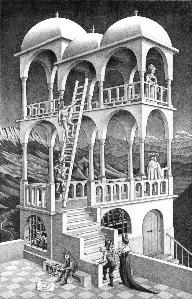What can Market Researchers learn from Escher?
Posted by Ray Poynter 30 July 2018

MS Escher Belvedere – linked from Wikipedia.
Last week I was lucky enough to be able to visit the Miracle of Escher exhibition at the Ueno Royal Museum. After the visit my mind turned to the lessons market researchers can draw from the works of MS Escher.
1) The first lesson is that humans see patterns, even when patterns are not really there
Escher’s Belvedere creates a building that can’t actually exist. If you look at the man and the ladder, you will note that it sits across the narrow dimension on the bottom floor, but arrives at the wide aspect of the upper floor. Most researchers will have faced a situation when there is an error in the data, but their initial response is often to make sense of the data. They tend to see a pattern when one does not exist.
2) Stories can help identify problems
By following a story through you can often see the fallacy of a false pattern. Taking the example of Belvedere, If we follow through the story of the man on the ladder we can see that he starts on the narrow side of the building but arrives on the wide side – a contradiction that should tell us that something is wrong. This is analogous to following customer journeys, checking to see if the data and our impression actually match what people do.
3) Good curation is the secret to building a composite picture
Like all good exhibitions, the Ueno Royal Museum had not simply hung the paintings on the wall, they had not put all ‘the good stuff’ at the start or the end. The curation comprised two key themes, firstly the subjects (science, buildings, human figures, religiosity etc), and the second axis was time, from the earliest to the latest). Through this curation (or storytelling) the visitor saw how Escher developed from a relatively conventional start through to the insights his post-war pictures offered. The link to science was explored, leaving the visitor in no doubt that Escher was on a purposeful journey of exploration, he did not stumble on these phenomena, he built on the greats of the past (such as the fantastic illustrations of 15th Century Hieronymus Bosch).
4) Create Engagement and Attachment
At the exit to the exhibition, the museum had created an interactive experience, designed to create a meme – something that InSites’ Tom de Ruyck has been suggesting for a while. You can see the result of my experience below: